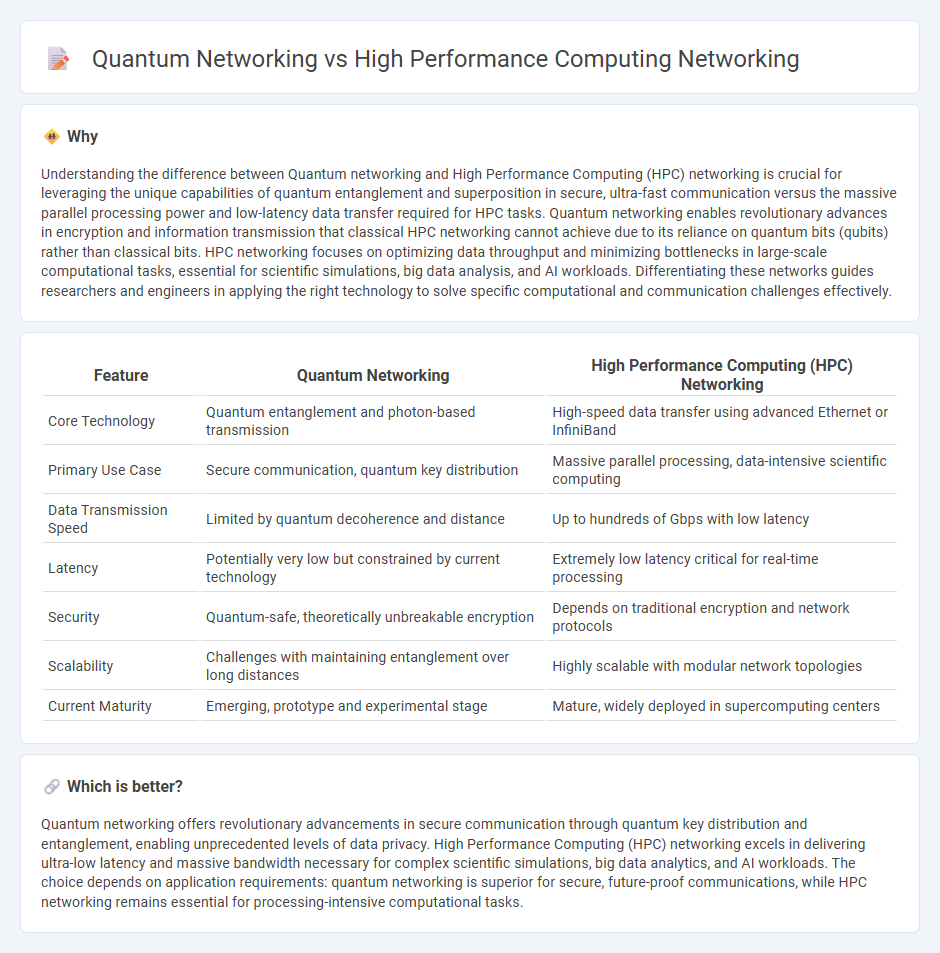
Quantum networking leverages principles of quantum mechanics to enable ultra-secure communication and unparalleled data transfer speeds, contrasting with High Performance Computing (HPC) networking that focuses on maximizing data throughput and minimizing latency across massive computational clusters. Quantum networks utilize qubits and entanglement for information exchange, while HPC networks rely on traditional hardware and protocols to support parallel processing tasks in scientific and industrial applications. Explore the differences and future potential of these cutting-edge networking technologies to understand their impact on computing evolution.
Why it is important
Understanding the difference between Quantum networking and High Performance Computing (HPC) networking is crucial for leveraging the unique capabilities of quantum entanglement and superposition in secure, ultra-fast communication versus the massive parallel processing power and low-latency data transfer required for HPC tasks. Quantum networking enables revolutionary advances in encryption and information transmission that classical HPC networking cannot achieve due to its reliance on quantum bits (qubits) rather than classical bits. HPC networking focuses on optimizing data throughput and minimizing bottlenecks in large-scale computational tasks, essential for scientific simulations, big data analysis, and AI workloads. Differentiating these networks guides researchers and engineers in applying the right technology to solve specific computational and communication challenges effectively.
Comparison Table
| Feature | Quantum Networking | High Performance Computing (HPC) Networking |
|---|---|---|
| Core Technology | Quantum entanglement and photon-based transmission | High-speed data transfer using advanced Ethernet or InfiniBand |
| Primary Use Case | Secure communication, quantum key distribution | Massive parallel processing, data-intensive scientific computing |
| Data Transmission Speed | Limited by quantum decoherence and distance | Up to hundreds of Gbps with low latency |
| Latency | Potentially very low but constrained by current technology | Extremely low latency critical for real-time processing |
| Security | Quantum-safe, theoretically unbreakable encryption | Depends on traditional encryption and network protocols |
| Scalability | Challenges with maintaining entanglement over long distances | Highly scalable with modular network topologies |
| Current Maturity | Emerging, prototype and experimental stage | Mature, widely deployed in supercomputing centers |
Which is better?
Quantum networking offers revolutionary advancements in secure communication through quantum key distribution and entanglement, enabling unprecedented levels of data privacy. High Performance Computing (HPC) networking excels in delivering ultra-low latency and massive bandwidth necessary for complex scientific simulations, big data analytics, and AI workloads. The choice depends on application requirements: quantum networking is superior for secure, future-proof communications, while HPC networking remains essential for processing-intensive computational tasks.
Connection
Quantum networking leverages the principles of quantum mechanics to enable ultra-secure communication and enhanced data processing capabilities. High Performance Computing (HPC) networking facilitates rapid data transfer and low-latency interconnects essential for processing large-scale simulations and computations. The integration of quantum networking within HPC environments promises to revolutionize computational speed and security by enabling quantum-enhanced algorithms and encrypted data exchange.
Key Terms
Latency
High Performance Computing (HPC) networking typically achieves latency in the range of microseconds by utilizing high-speed interconnects like InfiniBand or Omni-Path, critical for parallel processing efficiency and distributed computing tasks. Quantum networking aims to leverage quantum entanglement and superposition to potentially reduce latency to near-instantaneous levels over long distances, revolutionizing secure communication and data transfer speeds. Explore how advancements in both HPC and quantum networking are shaping the future of ultra-low latency communication technologies.
Entanglement
High performance computing (HPC) networking relies on traditional data transfer protocols optimized for speed and scalability across classical hardware, while quantum networking leverages quantum entanglement to enable instantaneous and secure information exchange through quantum states. Entanglement in quantum networking facilitates phenomena like quantum teleportation and superdense coding, which drastically differ from HPC's classical communication, enhancing computation power and security. Explore the nuances of entanglement's role in transforming network paradigms by learning more about quantum networking innovations.
Bandwidth
High Performance Computing (HPC) networking primarily relies on advanced interconnects like InfiniBand and Ethernet, delivering bandwidths reaching up to 400 Gbps to facilitate massive parallel data transfers between compute nodes. In contrast, Quantum networking involves the transmission of quantum bits (qubits) using photons through fiber optic cables or free space, where bandwidth is less about raw data rates and more about maintaining quantum coherence and low error rates over quantum channels. Explore detailed comparisons of HPC and Quantum networking bandwidth challenges and technological advances to understand their distinct roles in future computing infrastructures.
Source and External Links
Networks for High-Performance Computing - Highlights the essential role of low-latency, high-bandwidth networks (such as Cray's Aries and Mellanox's Infiniband) in HPC, emphasizing Remote Direct Memory Access (RDMA) for efficient data movement without CPU intervention.
What is High Performance Computing - Explains that HPC clusters interconnect hundreds or thousands of compute servers (nodes), requiring networking components that can handle rapid data transfer between nodes and storage to avoid becoming a performance bottleneck.
What Is High-Performance Computing (HPC)? - Describes how emerging RDMA fabrics like InfiniBand and RDMA over Converged Ethernet enable low-latency, high-throughput networking crucial for both on-premises and cloud-based HPC, supporting advanced applications such as AI and large-scale scientific simulations.
 dowidth.com
dowidth.com